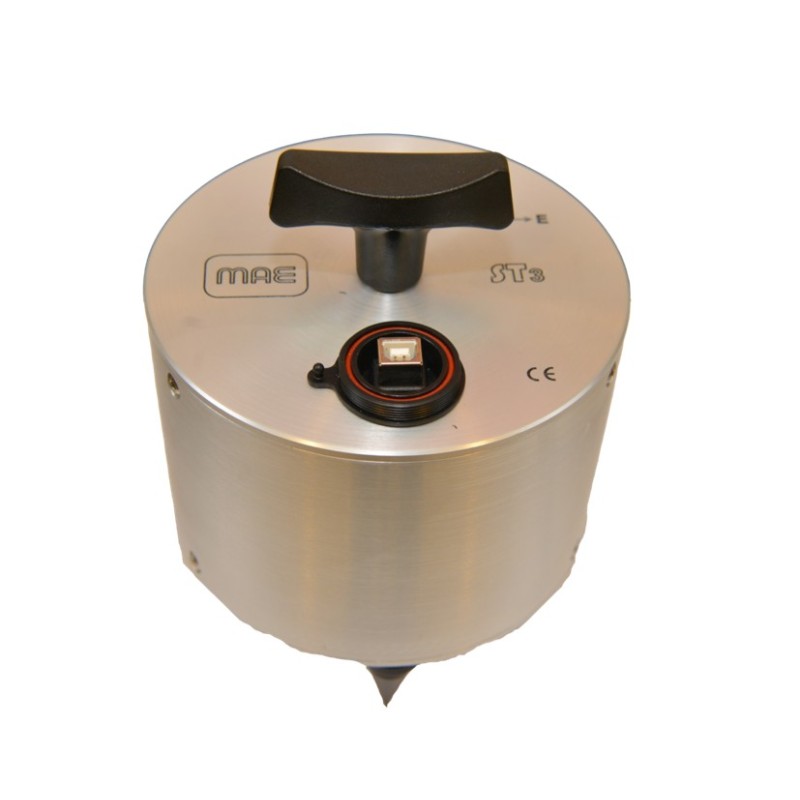
Reference: VH400-2M
Brand: VEGETRONIX

Reference: VH400-2M
Brand: VEGETRONIX
Reference: STC-24
Brand: Meatrol
Reference: 10HS ECHO - 5Mts
Reference: BASE-U-4
Reference: UA-002-64
Brand: ONSET





Description
The ST3 instrument integrates within an acquisition board equipped with 3 channels with 24 bit resolution for each channel and a 3D sensor with geophones with a natural frequency of 2 Hz. The instrumentation is managed via a laptop or tablet PC connected to the instrumentation via USB connection.
Methodologies
M.A.S.W. (Multichannel Analysis of Surface Waves

The MASW (Multichannel Analysis of Surface Waves) technique has the objective to identify variation profiles with the depth of the speeds of volume waves (Vp and Vs). The method is based on the known relations between these speeds and the dispersion of surface (or Rayleigh) waves observed when propagating through a stratified elastic medium. The analysis can be based on signals produced with a borehole on site by acquisition device (with a ram or explosion), or on the recording of the vibrations produced by far away sources (rives, industrial activities, traffic, etc).
In the first case, we are talking about active MASW, with which it is possible to explore a few tens of metres of sub-soil, and in the second case, we are talking about passive MASW, that allows to reach greater depths, in particular conditions.
Passive MA.S.W. is used with the purpose to obtain a speed profile 1D of the elastic waves of cut S. The technique consists in the recording of the “seismic noise” in temporal windows and following study of the signal processed. It is carried out by arranging a bidimensional geophonic chain with low resonant frequency in line or in “array” (circular and irregular geometries) and measuring the environmental noise. From the F-K analysis (frequency-space) of the wave-trains, it is possible to obtain a dispersion curve of surface waves that leads to the calculation of the speed profile of the shear waves and estimate of a coverage in relation to the semispace.
Nakamura Method, HVSR, H/V

A significant part of the damages observed in destructive earthquakes all over the world is associated with the amplification of seismic waves due to the effects of the local site. The analysis of the site response is therefore essential in the evaluation of the seismic risk in areas subject to earthquakes. In order to evaluate the effects of the local site, a series of surveys must be carried out. Among the empiric methods, the method of spectrum analyses H/V on environmental vibrations is one of the most common. The method, also called “Nakamura” technique (Nakamura, 1989), was introduced by Nogoshi and Igarashi (1971) based on the initial studies of Kanai and Tanaka (1961). Since then, many researchers worldwide performed a large number of applications.
An important requirement to carry out the H/ V method consists in a fairly good knowledge of seismology combined with basic information on local geological conditions supported by geo-physical and geo-technical data. The method is generally applied in micro-zoning studies and in the analysis of the local response of specific sites.
Technical Specifications
General
Acquisition
Your review appreciation cannot be sent
Report comment
Report sent
Your report cannot be sent
Write your review
Review sent
Your review cannot be sent
Reference: S1SA1S
Brand: MAE
Reference: DL8M
Brand: MAE
Reference: SONIC15
Brand: MAE
Reference: TCR24
Brand: MAE
Reference: X624EM
Brand: MAE
Reference: ST2424
Brand: MAE
Reference: X824S
Brand: MAE
Reference: GMS
Brand: MAE
Reference: CRONOSONIC
Brand: MAE
Reference: ET300
Brand: MAE
Reference: VMR624
Brand: MAE
Reference: CRONOSONIC
Brand: MAE
Reference: C313SEV
Brand: MAE

Description
The ST3 instrument integrates within an acquisition board equipped with 3 channels with 24 bit resolution for each channel and a 3D sensor with geophones with a natural frequency of 2 Hz. The instrumentation is managed via a laptop or tablet PC connected to the instrumentation via USB connection.
check_circle
check_circle